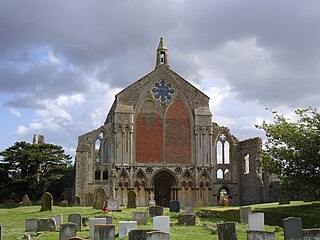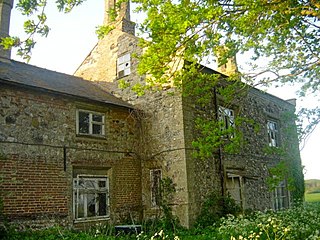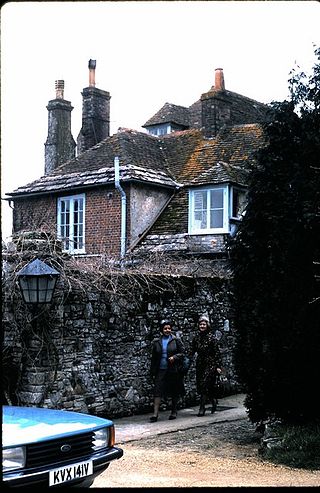Related Research Articles

Deerhurst is a village and civil parish in Gloucestershire, England, about 2 miles (3 km) southwest of Tewkesbury. The village is on the east bank of the River Severn. The parish includes the village of Apperley and the hamlet of Deerhurst Walton. The 2011 Census recorded the parish's population as 906, the majority of whom live in Apperley.

Sir Thomas Erpingham was an English soldier and administrator who loyally served three generations of the House of Lancaster, including Henry IV and Henry V, and whose military career spanned four decades. After the Lancastrian usurpation of the English throne in 1399, his career in their service was transformed as he rose to national prominence, and through his access to royal patronage he acquired great wealth and influence.

Mount Grace Priory is a monastery in the parish of East Harlsey, North Yorkshire, England. Set in woodlands within the North York Moors National Park, it is represented today by the best preserved and most accessible ruins among the nine houses of the Carthusian Order, which existed in England in the Middle Ages and were known as charterhouses.

St Mary's Priory, Binham, or Binham Priory, is a ruined Benedictine priory located in the village of Binham in the English county of Norfolk.

The Abbey of Sainte-Trinité, better known as the Abbaye aux Dames, is a former Benedictine nunnery in Caen, Normandy, now home to the Regional Council of Normandy. The complex includes the Church of Sainte-Trinité.

William Phelip, 6th Baron Bardolf, was an English landowner, soldier, politician, and administrator from Dennington in Suffolk.
The Priory of St. Andrews of the Ards (Blackabbey) was a Benedictine Abbey in County Down, Ireland. It was founded by John de Courcy as a daughter-house of the alien Benedictine Priory at Stogursey in Somerset, England. As Stogursey Priory was itself a cell of Lonlay-l'Abbaye in Normandy, Blackabbey also became affiliated to that house. In around 1356 the Blackabbey, with all its lands, was effectively dissolved and assigned by Lonlay to Richard FitzRalph, Archbishop of Armagh and his successors, under whom it continued.

Winnold House, formerly the Benedictine Priory of St Winwaloe, is a country house in the parish of Wereham in Norfolk, England. The house is constructed from the remaining fragments of a former Benedictine priory. The priory was founded in 1199 and was dissolved in 1321. It was demolished in 1539, and the surviving fragments were incorporated into a house sometime in the 17th century; it was rebuilt in the mid-19th century. It is a Grade II* listed building.

Wareham Priory was a monastery in Wareham, Dorset, England.

Pamber Priory is a Church of England parish church and former priory, then known as West Sherborne Priory or Monk Sherborne Priory, at Monk Sherborne in the English county of Hampshire.
Cammeringham Priory was a priory in Cammeringham, Lincolnshire, England, and was one of nine Premonstratensian houses in the historical county.
Covenham Priory was a priory in Covenham St Bartholomew, Lincolnshire, England.
Hough Priory was a priory in Hough-on-the-Hill, Lincolnshire, England. The manor on which the priory of Hough was afterwards built was granted by Henry I to his abbey of St. Mary de Voto at Cherbourg, for Austin canons. The parent abbey itself at its foundation contained only an abbot and four canons, and the cell having no other endowment than the manor and church of Hough, was intended for the support of a prior with a single chaplain for his companion, to maintain divine service for the soul of the king and his family.

St. Faith's Priory, Horsham, otherwise Horsham St. Faith Priory, was a Benedictine monastery in Horsham St Faith, Norfolk, England.

Pentney Priory was an Augustinian priory at Pentney in the district of King's Lynn and West Norfolk, Norfolk, England. The ruins of the priory, mostly comprising the flint-built gatehouse, are Grade I listed.
Toft Monks Priory was a priory at Toft Monks, Beccles, Norfolk, England. It included St Margarets, Toft Monks and St Mary, Haddiscoe

Monks Kirby Priory was a Benedictine priory established in 1077 in Monks Kirby, Warwickshire, England. The priory was suppressed in 1415 when its estates and revenues were given to the Carthusian priory of Axholme in Lincolnshire, in whose possession they continued until the Reformation. Remains of the priory form part of Monks Kirby village church today.
Warmington Priory was a Benedictine priory or more probably a cell in Warmington, Warwickshire, England. It was apparently founded by the monks of Préaux Abbey in Normandy after Henry de Newburgh, earl of Warwick, gave them his lands in Warmington in the reign of Henry I of England. Whatever its initial status, by the 14th century it was a cell of Toft Monks Priory in Norfolk, which similarly belonged to Préaux Abbey. After the dissolution of the alien priories by Henry V it was granted in 1428 to the Carthusians of Witham Charterhouse in Somerset.
Avebury Priory was an alien house of Benedictine monks in Wiltshire, England, between the early 12th century and the Dissolution.
References
- 1 2 Page, William, ed. (1906). "118. THE PRIORY OF HORSTEAD". A History of the County of Norfolk. Vol. 2. British History Online. Retrieved 21 December 2013.
- ↑ "Horstead-with-Stanninghall-(Parish-Summary) - Norfolk Heritage Explorer". www.heritage.norfolk.gov.uk. Retrieved 7 June 2023.